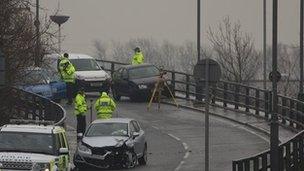Icy conditions in North East lead to collisions
- Published

Several vehicles were involved in the Blaydon crash
Drivers have been warned to be on their guard to avoid a repetition of the spate of collisions during the morning rush hour in the north east of England.
Rain falling on to frozen surfaces led to sheet ice and hazardous conditions for motorists and pedestrians.
Six vehicles, including a double-decker bus, crashed on the Felling bypass and several vehicles collided on Blaydon Highway flyover, both in Gateshead.
Temperatures overnight are expected to drop just below zero.
Gritters are in operation on all major routes.
Earlier, the A66 trans-Pennine route was closed for a time between Brough and Bowes but reopened at about 12:45 GMT.
Durham Police said they had received reports of a number of minor collisions around County Durham and Darlington.
Northumbria Police were called at about 06:45 GMT to the serious collision on the Blaydon Highway flyover, near its junction with Chainbridge Road.
One man, who had got out of his car, was hit by another vehicle and knocked over the barrier, falling some distance, the force said.
He was treated at the scene before being taken to hospital with possibly life-threatening injuries. His condition was later described as stable.
Police were also called to the Felling bypass crash scene, near to the Heworth roundabout, at about 08:20 GMT.
Several motorists suffered minor injuries and suffered shock.
Diversions were set up around both scenes.
'Moderate speed'
A van hit a tree on the Military Road between Greenhead and Walwick, in Northumberland at 07:00 GMT.
A double-decker bus was involved in a crash on the Felling bypass
Three people were in the vehicle and two men were taken to hospital, one with serious injuries.
Ch Insp Sarah Pitt, of Northumbria Police's Operations Command, said rain had fallen and frozen as soon as it hit road surfaces.
She said: "This is leading to very icy conditions and we would advise motorists to drive slowly and be mindful of this, even on roads that have been gritted.
"All areas are potentially hazardous in these conditions. Drivers should moderate their speed, keep a safe distance from the vehicle in front as stopping distances are longer on wet and icy roads, and they should try not to brake sharply."
On Thursday morning, BBC weatherman Paul Mooney said: "We have fairly hazardous roads and pavements.
"This is all because the temperatures have dropped to sub-zero again overnight and what has happened is that over the last few hours a band of cloud has brought slightly milder air and with it rain.
"So when that rain and drizzle hits those freezing roads and pavements it just freezes instantly and creates sheet ice.
"It might just look like a damp road or pavement but it's really ice and very, very dangerous."